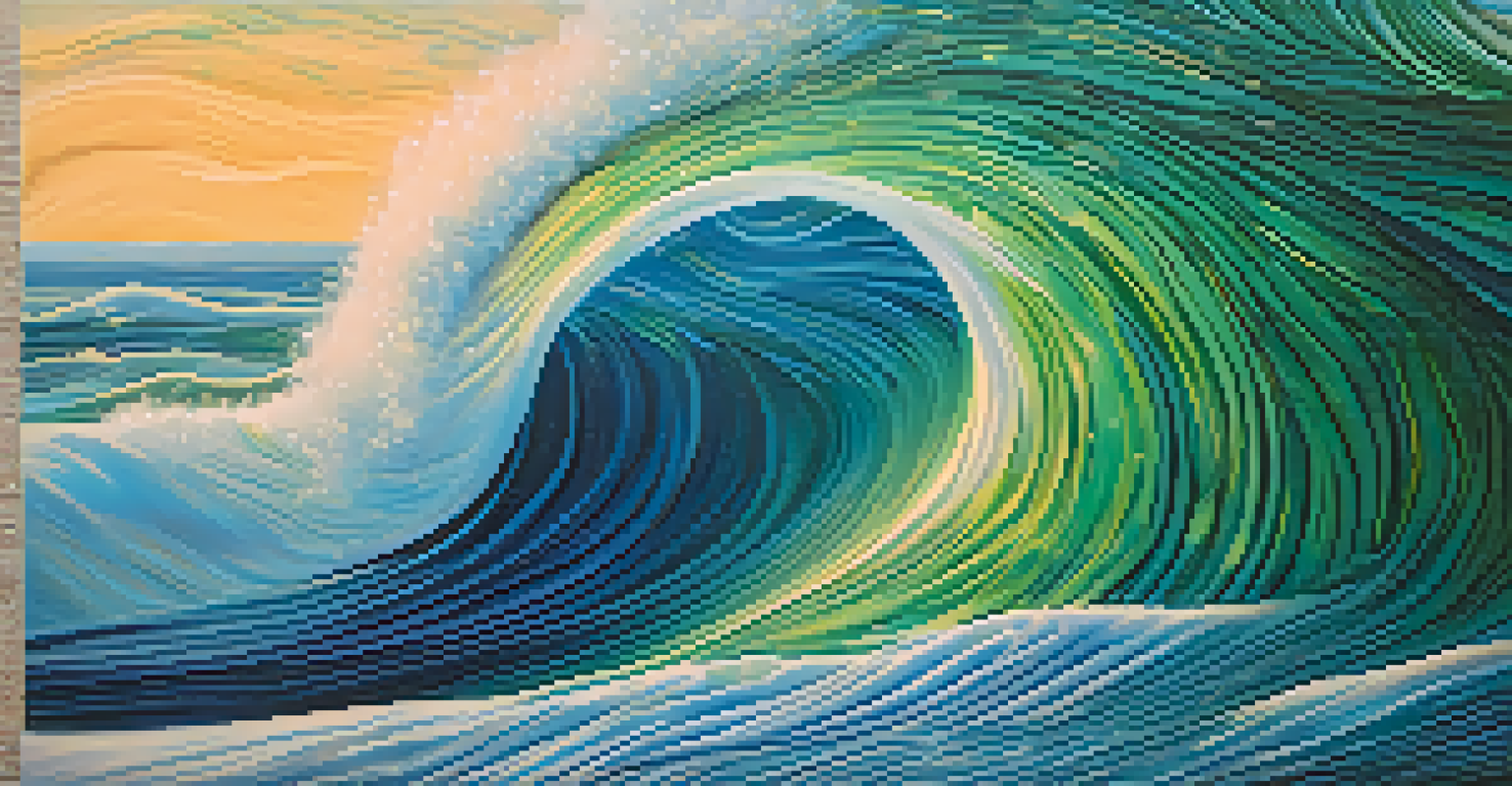Exploring the Psychological Impact of Color in Art Critique

The Basics of Color Psychology in Art
Color psychology studies how colors influence human emotions and behaviors. In art, colors can evoke feelings, set moods, and even communicate messages. For instance, warm colors like red and orange may elicit feelings of warmth and excitement, while cool colors such as blue and green often create a sense of calm. Understanding these reactions can enhance both the creation and critique of art.
Color is the keyboard, the eyes are the harmonies, the soul is the piano with many strings.
Artists intentionally use colors to express their intentions and connect with viewers. For example, Van Gogh's use of vibrant yellows in 'The Sunflowers' radiates happiness and energy, inviting viewers to feel joy. On the other hand, Picasso's blue period, characterized by shades of blue, conveys deep sadness and isolation. This contrast highlights the emotional range colors can bring to various artworks.
When critiquing art, recognizing the psychological impact of color can lead to deeper insights. It enables critics to consider not just what they see, but how they feel about the piece. This emotional response can ultimately shape the overall interpretation of the artwork, making color an essential aspect of art critique.
Cultural Context and Color Perception
Color perception isn't universal; it varies significantly across cultures. For instance, while white is often associated with purity in Western cultures, it can symbolize mourning in some Eastern cultures. This cultural context can greatly influence how an artwork is received and interpreted, making it crucial for critics to consider these differences.

Artists often draw from their cultural backgrounds when choosing colors, which can lead to rich and layered meanings. For example, in Mexican art, vibrant colors represent life and tradition, while in Japanese art, subtle hues may reflect nature’s tranquility. Understanding these cultural nuances allows art critics to appreciate the deeper significance behind color choices.
Symbolism Adds Depth to Color Use
Colors often carry symbolic meanings that enhance storytelling and convey deeper themes in art.
Moreover, acknowledging cultural context can prevent misinterpretations in art critique. A color that seems somber in one culture might be vibrant and celebratory in another. This awareness enriches the critique process, fostering a more inclusive approach to understanding art from diverse perspectives.
The Emotional Spectrum of Color
Colors can evoke a wide range of emotions, and artists harness this power to create emotional depth in their work. For instance, the use of red can stir passion and urgency, while softer colors like pastels may invoke tenderness and nostalgia. This emotional spectrum is a vital consideration in both the creation and critique of art.
Colors, like features, follow the changes of the emotions.
Take, for example, the contrasting use of dark versus light colors in an artwork. Dark colors might suggest mystery or foreboding, while light colors can impart feelings of safety and openness. Critics can analyze these emotional cues to better understand the artist's intent and the impact on the audience’s experience.
By exploring the emotional spectrum of color, critics can delve deeper into the narrative an artwork presents. This approach not only enhances their critique but also fosters a richer dialogue between the artwork and its audience, making the experience more meaningful.
The Role of Color in Composition
Color is a crucial element of composition in art, influencing how viewers navigate a piece. Through strategic color placement, artists can guide the viewer’s eye to focal points, creating a sense of flow and balance. For example, a bright color in a sea of muted tones can immediately draw attention, highlighting what the artist deems important.
Additionally, the harmony or contrast of colors can set the overall tone of the artwork. A monochromatic palette might evoke a sense of unity and calm, while contrasting colors can create tension and dynamism. Critics can assess how these compositional choices affect the viewer's experience, adding another layer to their critique.
Color Influences Emotions in Art
Colors are powerful tools in art that evoke emotions and set moods, shaping the viewer's experience.
Understanding the role of color in composition helps critics appreciate the technical skills behind an artwork. It also enables them to discuss how effectively the artist has used color to enhance storytelling and emotional resonance within their piece.
Symbolism and Color in Art
Colors often carry symbolic meanings that can vary widely. For example, green may symbolize nature and growth in one context, while in another, it could represent envy or greed. Artists frequently use these symbolic colors deliberately to convey messages and themes, making it essential for critics to recognize these layers of meaning.
Consider how many religious artworks utilize color symbolism to convey spiritual themes. In Christian art, blue often represents the divine, while red can symbolize sacrifice. Critics who understand these symbols can offer richer interpretations, connecting the artwork to broader cultural or spiritual narratives.
By examining the symbolism of color, critics can uncover deeper insights into the artist's intention. This exploration enhances the critique process, allowing for a more nuanced appreciation of how color serves as a powerful tool for storytelling in art.
Color and Memory in Art Appreciation
Colors can trigger memories and associations, making them a powerful element in art appreciation. For many, a specific shade might remind them of a cherished moment, influencing their emotional response to an artwork. This personal connection can enhance the viewing experience, making art feel more relevant and impactful.
Artists often use color to evoke a sense of nostalgia or to comment on the passage of time. For instance, sepia tones in photographs can transport viewers back to a different era, creating a sense of longing. Critics can explore how these color choices resonate with personal or collective memories, enriching their analysis.
Cultural Context Affects Color Meaning
The perception of color varies across cultures, impacting how artworks are interpreted and appreciated.
By acknowledging the role of memory in color perception, critics can foster a more intimate dialogue between the artwork and its audience. This connection not only enhances the critique but also invites viewers to engage with art on a personal level, making the experience more profound.
The Future of Color in Art and Critique
As technology evolves, so does the way we perceive and utilize color in art. Digital mediums offer new possibilities for color manipulation, allowing artists to experiment in unprecedented ways. This evolution invites critics to adapt their approaches, considering how these innovations impact our understanding of color and its psychological effects.
Furthermore, the rise of virtual and augmented reality in art aims to create immersive experiences that heighten color perception. Imagine walking through a virtual gallery where colors shift and change based on your emotions. Critics will need to explore how these advancements challenge traditional notions of color and its role in art critique.

Embracing the future of color in art opens up exciting discussions and possibilities for critics. By staying attuned to these changes, they can continue to provide insightful analyses that resonate with contemporary audiences and reflect the dynamic nature of artistic expression.